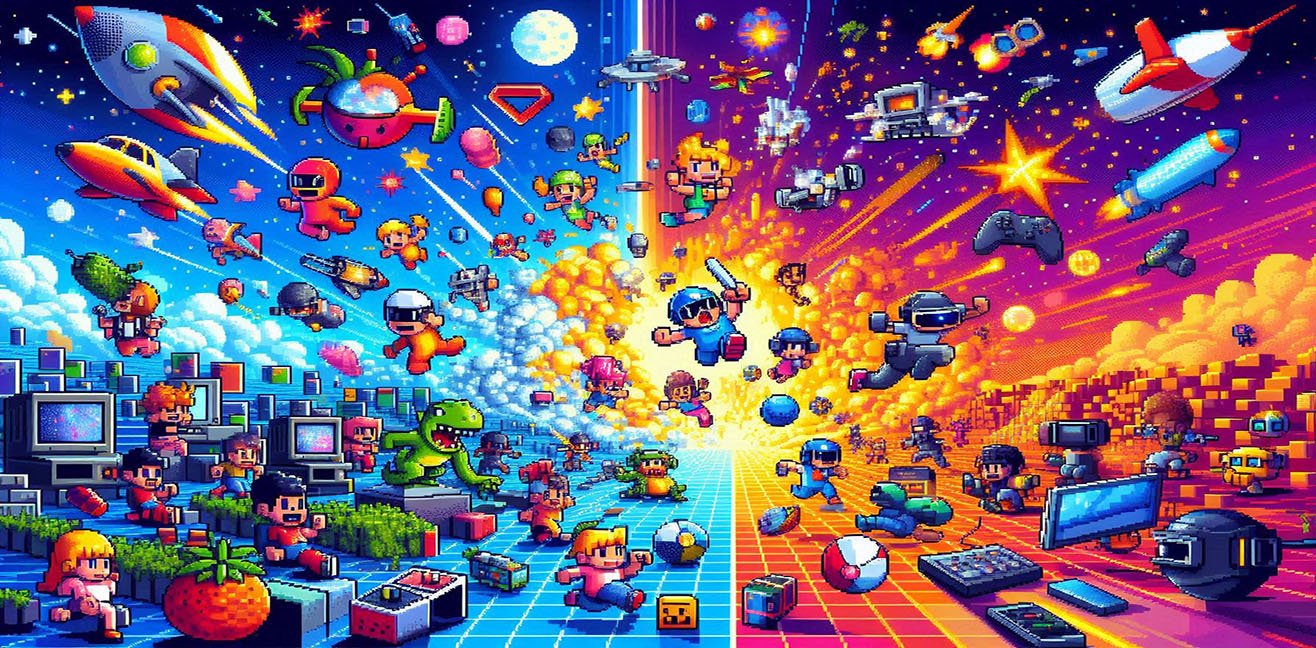Imagine this: it’s the 1980s, you’re holding a joystick, staring at 8-bit worlds on your screen… Fast forward to today, and you’re playing in 4K resolution, HDR lighting, with graphics almost lifelike. Welcome to the evolution of gaming! ⚡
Games aren’t just entertainment—they’re laboratories of technology, art, and culture. Retro games bring nostalgia, while modern games amaze with technology and realism. Get ready, my love, this journey is like a lightspeed warp from pixels to 4K! 😎✨
🕹️ Retro Games: Pixel Art and Simple Yet Challenging Mechanics
When we say retro games, we think Atari, NES, Game Boy… Creating huge worlds from tiny pixel blocks and developing simple but effective mechanics.
- Graphics: 8-bit and 16-bit pixel worlds. Every pixel feels like a character, minimal but creative.
- Sound: Beep-boop tunes that echo in our ears for decades.
- Gameplay: Simple controls but challenging levels. “Jump, run, attack with one button”—lose, and you start all over.
- Difficulty: Patience and reflexes rule. No save system; mistakes are brutally punished.
🌟 Humorous Note: Losing in retro games was easy: hit restart and try again. Losing in modern games? Hours-long raids, blaming your teammates, and epic fails! 😏
⚡ Modern Games: 4K, HDR, and Infinite Detail
Today’s games are revolutionary in graphics, physics engines, and sound technology.
- Graphics: 4K resolution, HDR, ray tracing for realistic lighting and shadows. Even skin textures and reflections are detailed. ✨
- Sound: 3D audio, realistic environmental effects, orchestral music. You can even hear a single falling leaf.
- Gameplay: Complex mechanics, multi-character control, and online community interactions.
- Difficulty: Strategy + reflexes + coordination. Losing can involve hours-long missions and epic fails. 😂
💡 Technical Note: Modern games rely on GPU/CPU optimization, ray tracing, physics engines (Havok, PhysX), and AI-driven NPC behavior. The realism of a game depends entirely on these technologies.
🏆 Retro vs Modern: Technical and Fun Comparison
| Feature | Retro | Modern |
|---|---|---|
| Graphics | 8-bit, 16-bit pixels | 4K, HDR, ray tracing |
| Sound | Beep-boop | 3D audio, orchestral music |
| Gameplay | Simple, single mechanic | Complex, multi-mechanic |
| Difficulty | Patience and reflexes | Patience, strategy, team |
| Hardware | Minimal, joystick | High-performance PC/console |
| Humor | Simple funny mistakes | Fun bugs and epic reactions |
😂 Humor and Gaming Culture
Retro games make us laugh with glitches, while modern games entertain with funny bugs, lag moments, and online drama.
- Retro: Pixel character falls, disappears, restart with one button.
- Modern: Lag makes your team blame you, epic fail moments get recorded, millions watch on Twitch! 📺😂
💻 Technical Depth: Hardware and Software Evolution
- Retro: Minimal hardware, simple CPUs, small RAM. Games were lightweight and optimized.
- Modern: Powerful GPUs/CPUs, high FPS, 1ms input lag, ray tracing, AI, online server infrastructure… All for a flawless experience.
🌟 Humorous Note: Retro games were tiny and your computer never complained. Modern games? “Downloading patch… my internet is crying!” 😏
🎬 Final Word: From Pixels to 4K
Games have evolved into a fusion of art, technology, and entertainment. Retro and modern games aren’t rivals; they’re two worlds that complement each other.
Playing retro games brings nostalgia and simple pleasures. Modern games offer realistic graphics, detail, and community experiences. Both hold a special place in our hearts. 💖
🌟 Humorous Finale: Sometimes, playing a few rounds of retro games makes you feel young again, then switching to a modern game makes you say, “Wow, technology has really leveled up!” That, my love, is the true superpower of gaming! 😎🎮




